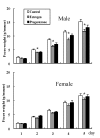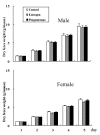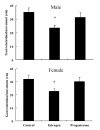Estrogen rather than progesterone cause constipation in both female and male mice
- PMID: 24227943
- PMCID: PMC3823955
- DOI: 10.4196/kjpp.2013.17.5.423
Estrogen rather than progesterone cause constipation in both female and male mice
Abstract
Females are more often affected by constipation than males, especially during pregnancy, which is related to the menstrual cycle. Although still controversial, alterations of progesterone and estrogen may be responsible. Therefore, this study was conducted in order to determine whether the female sex steroid hormone itself is responsible for development of constipation in both female and male mice. Administration of estrogen resulted in a decrease in weight of accumulated feces on days 2, 3, 4, and 5 in male mice and on day 5 in female mice, compared with the control group, but progesterone administration did not. Administration of estrogen resulted in a decrease in gastrointestinal movement, compared to normal; however, no significant change was observed by administration of progesterone. In conclusion, estrogen, rather than progesterone, may be a detrimental factor of constipation via decreased bowel movement in mice.
Keywords: Constipation; Estrogen; Progesterone.
Figures




Similar articles
-
Effect of female sex hormone supplementation and withdrawal on gastrointestinal and colonic transit in postmenopausal women.Neurogastroenterol Motil. 2006 Oct;18(10):911-8. doi: 10.1111/j.1365-2982.2006.00808.x. Neurogastroenterol Motil. 2006. PMID: 16961694 Clinical Trial.
-
Hormonal changes throughout the menstrual cycle and increased anterior cruciate ligament laxity in females.J Athl Train. 1999 Apr;34(2):144-9. J Athl Train. 1999. PMID: 16558557 Free PMC article.
-
Importance of progesterone in DNA synthesis of pregnancy-dependent mammary tumors in mice.Int J Cancer. 1976 Sep 15;18(3):317-21. doi: 10.1002/ijc.2910180308. Int J Cancer. 1976. PMID: 986372
-
Mode of action of RU 486.Ann Med. 1993 Feb;25(1):61-4. doi: 10.3109/07853899309147859. Ann Med. 1993. PMID: 8435191 Review.
-
[Individualization of low-dose oral contraceptives. Pharmacological principles and practical indications for oral contraceptives].Minerva Ginecol. 2007 Aug;59(4):415-25. Minerva Ginecol. 2007. PMID: 17923832 Review. Italian.
Cited by
-
Constipation and diarrhea during the menopause transition and early postmenopause: observations from the Seattle Midlife Women's Health Study.Menopause. 2018 Jun;25(6):615-624. doi: 10.1097/GME.0000000000001057. Menopause. 2018. PMID: 29381667 Free PMC article.
-
Irinotecan-induced neutropenia is reduced by oral alkalization drugs: analysis using retrospective chart reviews and the spontaneous reporting database.Support Care Cancer. 2019 Mar;27(3):849-856. doi: 10.1007/s00520-018-4367-y. Epub 2018 Jul 31. Support Care Cancer. 2019. PMID: 30062585
-
Prevalence and risk factor for chronic diarrhea in participants of a Japanese medical checkup.JGH Open. 2021 Dec 29;6(1):69-75. doi: 10.1002/jgh3.12704. eCollection 2022 Jan. JGH Open. 2021. PMID: 35071791 Free PMC article.
-
Prevalence of common canine digestive problems compared with other health problems in teaching veterinary hospital, Faculty of Veterinary Medicine, Cairo University, Egypt.Vet World. 2015 Mar;8(3):403-11. doi: 10.14202/vetworld.2015.403-411. Epub 2015 Mar 26. Vet World. 2015. PMID: 27047105 Free PMC article.
-
Expression of Sex Steroid Hormone Receptors in Vagal Motor Neurons Innervating the Trachea and Esophagus in Mouse.Acta Histochem Cytochem. 2016 Feb 27;49(1):37-46. doi: 10.1267/ahc.15037. Epub 2016 Feb 24. Acta Histochem Cytochem. 2016. PMID: 27006520 Free PMC article.
References
-
- Chatoor D, Emmnauel A. Constipation and evacuation disorders. Best Pract Res Clin Gastroenterol. 2009;23:517–530. - PubMed
-
- Foxx-Orenstein AE, McNally MA, Odunsi ST. Update on constipation: one treatment does not fit all. Cleve Clin J Med. 2008;75:813–824. - PubMed
-
- Chang L, Toner BB, Fukudo S, Guthrie E, Locke GR, Norton NJ, Sperber AD. Gender, age, society, culture, and the patient's perspective in the functional gastrointestinal disorders. Gastroenterology. 2006;130:1435–1446. - PubMed
-
- Wald A, Van Thiel DH, Hoechstetter L, Gavaler JS, Egler KM, Verm R, Scott L, Lester R. Effect of pregnancy on gastrointestinal transit. Dig Dis Sci. 1982;27:1015–1018. - PubMed
LinkOut - more resources
Full Text Sources
Other Literature Sources

